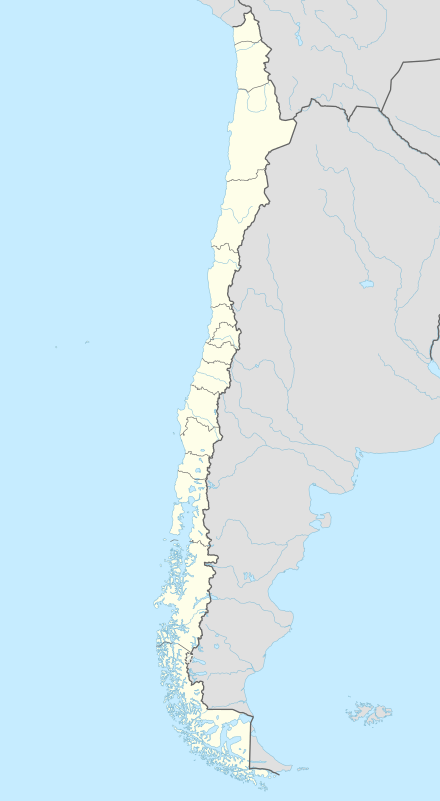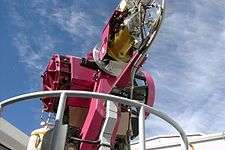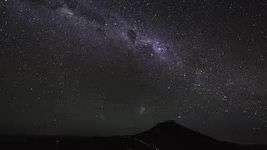European Southern Observatory
|
ESO logo and map of participating countries | |
| Formation | 1962 |
|---|---|
| Type | Intergovernmental organization |
| Purpose | Research organization for astronomy |
| Headquarters | Garching, Germany |
Membership | 16 (15 European countries and Brazil) |
Official language |
Czech, Danish, Dutch, English, Finnish, French, German, Italian, Norwegian, Polish, Portuguese, Spanish, Swedish |
Director General | Tim de Zeeuw |
| Slogan | Reaching New Heights in Astronomy |
| Website | ESO.org |

The European Southern Observatory (ESO, formally: European Organization for Astronomical Research in the Southern Hemisphere; French: Organisation Européenne pour des Recherches Astronomiques dans l'Hémisphere Austral) is a 16-nation intergovernmental research organization for ground-based astronomy. Created in 1962, ESO has provided astronomers with state-of-the-art research facilities and access to the southern sky. The organisation employs about 730 staff members and receives annual member state contributions of approximately €131 million.[1] Its observatories are located in northern Chile.
ESO has built and operated some of the largest and most technologically advanced telescopes. These include the New Technology Telescope, an early pioneer in the use of active optics, and the Very Large Telescope (VLT), which consists of four individual telescopes, each with a primary mirror 8.2 metre across, and four smaller auxiliary telescopes. The Atacama Large Millimeter Array observes the universe in the millimetre and submillimetre wavelength ranges, and is the world's largest ground-based astronomy project to date. It was completed in March 2013 in an international collaboration by Europe (represented by ESO), North America, East Asia and Chile.[2][3]
Currently under construction is the European Extremely Large Telescope. It will use a 39.3-metre-diameter segmented mirror, and become the world's largest optical reflecting telescope when operational in 2024. Its light-gathering power will allow detailed studies of planets around other stars, the first objects in the universe, supermassive black holes, and the nature and distribution of the dark matter and dark energy which dominate the universe.
ESO's observing facilities have made astronomical discoveries and produced several astronomical catalogues.[4] Its findings include the discovery of the most distant gamma-ray burst and evidence for a black hole at the centre of the Milky Way.[5][6] In 2004, the VLT allowed astronomers to obtain the first picture of an extrasolar planet (2M1207b) orbiting a brown dwarf 173 light-years away.[7] The High Accuracy Radial Velocity Planet Searcher (HARPS) instrument installed in another ESO telescope led to the discovery of extrasolar planets, including Gliese 581 c—one of the smallest planets seen outside the solar system.[8]
History

The idea that European astronomers should establish a common large observatory was broached by Walter Baade and Jan Oort at the Leiden Observatory in the Netherlands in spring 1953.[10] It was pursued by Oort, who gathered a group of astronomers in Leiden to consider it on June 21 that year. Immediately thereafter, the subject was further discussed at the Groningen conference in the Netherlands. On January 26, 1954, an ESO declaration was signed by astronomers from six European countries expressing the wish that a joint European observatory be established in the southern hemisphere.[11]
At the time, all reflector telescopes with an aperture of 2 metres or more were located in the northern hemisphere. The decision to build the observatory in the southern hemisphere resulted from the necessity of observing the southern sky; some research subjects (such as the central parts of the Milky Way and the Magellanic Clouds) were accessible only from the southern hemisphere.[12]
| ESO directors general | |
|---|---|
| Otto Heckmann | 1962–1969 |
| Adriaan Blaauw | 1970–1974 |
| Lodewijk Woltjer | 1975–1987 |
| Harry van der Laan | 1988–1992 |
| Riccardo Giacconi | 1993–1999 |
| Catherine Cesarsky | 1999–2007 |
| Tim de Zeeuw | 2007–present |
| Source: www.eso.org, about ESO[13] | |
Although it was initially planned to set up telescopes in South Africa (where several European observatories were located), tests from 1955 to 1963 demonstrated that a site in the Andes was preferable. On November 15, 1963 Chile was chosen as the site for ESO's observatory.[14] The decision was preceded by the ESO Convention, signed 5 October 1962 by Belgium, Germany, France, the Netherlands and Sweden. Otto Heckmann was nominated as the organisation's first director general on 1 November 1962.
A preliminary proposal for a convention of astronomy organisations in these five countries was drafted in 1954. Although some amendments were made in the initial document, the convention proceeded slowly until 1960 when it was discussed during that year's committee meeting. The new draft was examined in detail, and a council member of CERN (the European Organization for Nuclear Research) highlighted the need for a convention between governments (in addition to organisations).[15]
The convention and government involvement became pressing due to rapidly rising costs of site-testing expeditions. The final 1962 version was largely adopted from the CERN convention, due to similarities between the organisations and the dual membership of some members.[16]
In 1966, the first ESO telescope at the La Silla site in Chile began operating.[11] Because CERN (like ESO) had sophisticated instrumentation, the astronomy organisation frequently turned to the nuclear-research body for advice and a collaborative agreement between ESO and CERN was signed in 1970. Several months later, ESO's telescope division moved into a CERN building in Geneva and ESO's Sky Atlas Laboratory was established on CERN property.[17] ESO's European departments moved into the new ESO headquarters in Garching (near Munich), Germany in 1980.



Member states
| Country | Date joined[19] |
|---|---|
| |
1962 |
| |
1962 |
| |
1962 |
| |
1962 |
| |
1962 |
| |
1967 |
| |
1981 |
| |
24 May 1982 |
| |
27 June 2000 |
| |
8 July 2002 |
| |
1 July 2004 |
| |
1 July 2006 |
| |
1 January 2007 |
| |
1 July 2008 |
| |
29 December 2010 (pending) |
| |
28 October 2014 |

Chilean observation sites
Although ESO is headquartered in Germany, its telescopes and observatories are in northern Chile, where the organisation operates advanced ground-based astronomical facilities:
- La Silla, which hosts the New Technology Telescope (NTT)
- Paranal, where the Very Large Telescope (VLT) is located
- Llano de Chajnantor, which hosts the APEX (Atacama Pathfinder Experiment) submillimetre telescope and where ALMA, the Atacama Large Millimeter/submillimeter Array, is located
These are among the best locations for astronomical observations in the southern hemisphere.[22] An ESO project is the European Extremely Large Telescope (E-ELT), a 40-metre-class telescope based on a five-mirror design and the formerly planned Overwhelmingly Large Telescope. The E-ELT will be the largest optical near-infrared telescope in the world. ESO began its design in early 2006, and aimed to begin construction in 2012.[23] Construction work at the E-ELT site started in June 2014.[24] As decided by the ESO council on 26 April 2010, a fourth site (Cerro Armazones) is to be home to E-ELT.[25][26][27]
Each year about 2,000 requests are made for the use of ESO telescopes, for four to six times more nights than are available. Observations made with these instruments appear in a number of peer-reviewed publications annually; in 2009, more than 650 reviewed papers based on ESO data were published.[28]
ESO telescopes generate large amounts of data at a high rate, which are stored in a permanent archive facility at ESO headquarters. The archive contains more than 1.5 million images (or spectra) with a total volume of about 65 terabytes (65,000,000,000,000 bytes) of data.
| ESO telescopes | |||||||
|---|---|---|---|---|---|---|---|
| Name | Short | Size | Type | Location | Year | ||
| ESO 3.6 m telescope – hosting HARPS | ESO 3.6m | 3.57 m | optical and infrared | La Silla | 1977 | ||
| MPG/ESO 2.2 m telescope | MPG | 2.20 m | optical and infrared | La Silla | 1984 | ||
| New Technology Telescope | NTT | 3.58 m | optical and infrared | La Silla | 1989 | ||
| Very Large Telescope | VLT | 4 × 8.2 m 4 × 1.8 m | optical to mid-infrared, array | Paranal | 1998 | ||
| Atacama Pathfinder Experiment | APEX | 12 m | millimetre-/submillimetre-wavelength | Chajnantor | 2005 | ||
| Visible and Infrared Survey Telescope for Astronomy | VISTA | 4.1 m | near-infrared, survey | Paranal | 2009 | ||
| VLT Survey Telescope | VST | 2.6 m | optical, survey | Paranal | 2011 | ||
| Atacama Large Millimeter/submillimeter Array[A] | ALMA | 50 × 12 m 12 × 7 m 4 × 12 m[29] | millimetre-/submillimetre-wavelength interferometer array | Chajnantor | 2011 | ||
| European Extremely Large Telescope | E-ELT | 39.3 m | optical to mid-infrared | Cerro Armazones[23] | 2024 | ||
| A ALMA is a partnership among Europe, the United States, Canada, East Asia and the Republic of Chile. · Additional ESO research facilities are located in Santiago, Chile and include a library, computing resources and programmes for visiting scientists.[30] · ESO also maintains close ties with other observatories and universities throughout the country.[31][32] · Source: ESO – Telescopes and Instrumentation[33] | |||||||
La Silla
La Silla, located in the southern Atacama Desert 600 kilometres (370 mi) north of Santiago de Chile at an altitude of 2,400 metres (7,900 ft), is the home of ESO's original observation site. Like other observatories in the area, La Silla is far from sources of light pollution and has one of the darkest night skies on earth.[34] In La Silla, ESO operates three telescopes: a 3.6-metre telescope, the New Technology Telescope (NTT) and the 2.2-metre Max-Planck-ESO Telescope.
The observatory hosts visitor instruments, attached to a telescope for the duration of an observational run and then removed. La Silla also hosts national telescopes, such as the 1.2-metre Swiss and the 1.5-metre Danish telescopes.
About 300 reviewed publications annually are attributable to the work of the observatory. Discoveries made with La Silla telescopes include the HARPS-spectrograph detection of the system around Gliese 581, which contains the first known rocky planet in a habitable zone outside the solar system.[35][36] Several telescopes at La Silla played a role in linking gamma-ray bursts, the most energetic explosions in the universe since the Big Bang, with the explosions of massive stars. The ESO La Silla Observatory also played a role in the study of supernova SN 1987A.[37]
ESO 3.6-metre telescope
The ESO 3.6-metre telescope began operations in 1977. It has been upgraded, including the installation of a new secondary mirror.[38] The conventionally designed horseshoe-mount telescope was primarily used for infrared spectroscopy; it now hosts the HARPS spectrograph, used in search of extra-solar planets and for asteroseismology. The telescope was designed for very high long-term radial velocity accuracy (on the order of 1 m/s).[39]
New Technology Telescope
The New Technology Telescope (NTT) is an altazimuth, 3.58-metre Ritchey-Chrétien telescope, inaugurated in 1989 and the first in the world with a computer-controlled main mirror. The flexible mirror's shape is adjusted during observation to preserve optimal image quality. The secondary mirror position is also adjustable in three directions. This technology (developed by ESO and known as active optics) is now applied to all major telescopes, including the VLT and the future E-ELT.[40]
The design of the octagonal enclosure housing the NTT is innovative. The telescope dome is relatively small and ventilated by a system of flaps directing airflow smoothly across the mirror, reducing turbulence and resulting in sharper images.[41]
MPG/ESO 2.2-metre telescope
The 2.2-metre telescope has been in operation at La Silla since early 1984, and is on indefinite loan to ESO from the Max Planck Society (Max-Planck-Gesellschaft zur Förderung der Wissenschaften, or MPG, in German). Telescope time is shared between MPG and ESO observing programmes, while operation and maintenance of the telescope are ESO’s responsibility.
Its instrumentation includes a 67-million-pixel wide-field imager (WFI) with a field of view as large as the full moon,[42] which has taken many images of celestial objects. Other instruments used are GROND (Gamma-Ray Burst Optical Near-Infrared Detector), which seeks the afterglow of gamma-ray bursts—the most powerful explosions in the universe,[43] and the high-resolution spectrograph FEROS (Fiber-fed Extended Range Optical Spectrograph), used to make detailed studies of stars.
Other telescopes
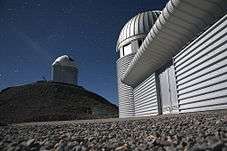
La Silla also hosts several national and project telescopes not operated by ESO. Among them are the Swiss Euler Telescope, the Danish National Telescope and the REM, TRAPPIST and TAROT telescopes.[44]
- The Euler Telescope is a 1.2-metre telescope built and operated by the Geneva Observatory in Switzerland. It is used to conduct high-precision radial velocity measurements primarily used in the search for large extrasolar planets in the southern celestial hemisphere. Its first discovery was a planet orbiting Gliese 86.[45] Other observing programmes focus on variable stars, asteroseismology, gamma-ray bursts, monitoring active galactic nuclei (AGN) and gravitational lenses.[46]
- The 1.54-metre Danish National Telescope was built by Grubb-Parsons and has been in use at La Silla since 1979. The telescope has an off-axis mount, and the optics are a Ritchey-Chrétien design. Because of the telescope's mount and limited space inside the dome, it has significant pointing restrictions.[47]

- The Rapid Eye Mount telescope is a small rapid-reaction automatic telescope with a primary 60-centimetre (24 in) mirror. The telescope, in an altazimuth mount, began operation in October 2002. The primary purpose of the telescope is to follow the afterglow of the GRBs detected by the Swift Gamma-Ray Burst Mission satellite.[44][49]
- The Belgian TRAPPIST is a joint venture between the University of Liège and Geneva Observatory. The 0.60-metre telescope is specialized in comets, exoplanets, and was one of the few telescopes that observed a stellar occultation of the dwarf planet Eris, revealing that it may be smaller than Pluto.[50]
- The Quick-action telescope for transient objects, TAROT, is a very fast-moving optical robotic telescope able to observe a gamma-ray burst from its beginning. Satellites detecting GRBs send signals to TAROT, which can provide a sub-arc second position to the astronomical community. Data from the TAROT telescope is also useful in studying the evolution of GRBs, the physics of a fireball and its surrounding material.[51] It is operated from the Haute-Provence Observatory in France.
Paranal
The Paranal Observatory is located atop Cerro Paranal in the Atacama Desert in northern Chile. Cerro Paranal is a 2,635-metre-high (8,645 ft) mountain about 120 kilometres (75 mi) south of Antofagasta and 12 kilometres (7.5 mi) from the Pacific coast.[52]
The observatory has seven major telescopes operating in visible and infrared light: the four 8.2-metre (27 ft) telescopes of the Very Large Telescope, the 2.6-metre (8 ft 6 in) VLT Survey Telescope (VST) and the 4.1-metre (13 ft) Visible and Infrared Survey Telescope for Astronomy. In addition, there are four 1.8-metre (5 ft 11 in) auxiliary telescopes forming an array used for interferometric observations.[53] In March 2008, Paranal was the location for several scenes of the 22nd James Bond film, Quantum of Solace.[54][55]

Very Large Telescope

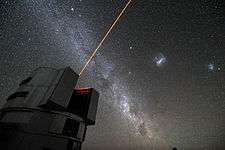
The main facility at Paranal is the VLT, which consists of four nearly identical 8.2-metre (27 ft) unit telescopes (UTs), each hosting two or three instruments. These large telescopes can also work together in groups of two or three as a giant interferometer. The ESO Very Large Telescope Interferometer (VLTI) allows astronomers to see details up to 25 times finer than those seen with the individual telescopes. The light beams are combined in the VLTI with a complex system of mirrors in underground tunnels, where the light paths must diverge less than 1/1000 mm over 100 metres. The VLTI can achieve an angular resolution of milliarcseconds, equivalent to the ability to see the headlights of a car on the moon.[56]
The first of the UTs had its first light in May 1998, and was offered to the astronomical community on 1 April 1999.[57] The other telescopes followed suit in 1999 and 2000, making the VLT fully operational. Four 1.8-metre auxiliary telescopes (ATs), installed between 2004 and 2007, have been added to the VLTI for accessibility when the UTs are used for other projects.[58]
Data from the VLT have led to the publication of an average of more than one peer-reviewed scientific paper per day; in 2007, almost 500 reviewed scientific papers were published based on VLT data.[59] The VLT's scientific discoveries include imaging an extrasolar planet,[60] tracking individual stars moving around the supermassive black hole at the centre of the Milky Way[61] and observing the afterglow of the furthest known gamma-ray burst.[62]
At the Paranal inauguration in March 1999, names of celestial objects in the Mapuche language were chosen to replace the technical designations of the four VLT Unit Telescopes (UT1–UT4). An essay contest was prior arranged for schoolchildren in the region concerning the meaning of these names which attracted many entries dealing with the cultural heritage of ESO's host country. A 17-year-old adolescent from Chuquicamata, near Calama, submitted the winning essay and was awarded an amateur telescope during the inauguration.[63] The four unit telescopes, UT1, UT2, UT3 and UT4, are since known as Antu (sun), Kueyen (moon), Melipal (Southern Cross), and Yepun (Evening Star),[64] with the latter having been originally mistranslated as "Sirius", instead of "Venus".[65]
Survey telescopes
Visible and Infrared Survey Telescope for Astronomy (VISTA) is housed on the peak adjacent to the one hosting the VLT, sharing observational conditions. VISTA’s main mirror is 4.1 metres (13 ft) across, a highly curved mirror for its size and quality. Its deviations from a perfect surface are less than a few thousandths the thickness of a human hair, and its construction and polishing presented a challenge.[66]
VISTA was conceived and developed by a consortium of 18 universities in the United Kingdom led by Queen Mary, University of London, and it became an in-kind contribution to ESO as part of the UK's ratification agreement. The telescope's design and construction were managed by the Science and Technology Facilities Council's UK Astronomy Technology Centre (STFC, UK ATC). Provisional acceptance of VISTA was formally granted by ESO at the December 2009 ceremony at ESO headquarters in Garching, which was attended by representatives of Queen Mary, University of London and STFC. Since then the telescope has been operated by ESO,[67] capturing quality images since it began operation.[68][69]
The VLT Survey Telescope (VST) is a state-of-the-art, 2.6-metre (8 ft 6 in) telescope equipped with OmegaCAM, a 268-megapixel CCD camera with a field of view four times the area of the full moon. It complements VISTA by surveying the sky in visible light. The VST (which became operational in 2011) is the result of a joint venture between ESO and the Astronomical Observatory of Capodimonte (Naples), a research centre at the Italian National Institute for Astrophysics INAF.[70][71]
The scientific goals of both surveys range from the nature of dark energy to assessing near-Earth objects. Teams of European astronomers will conduct the surveys; some will cover most of the southern sky, while others will focus on smaller areas. VISTA and the VST are expected to produce large amounts of data; a single picture taken by VISTA has 67 megapixels, and images from OmegaCam (on the VST) will have 268 megapixels. The two survey telescopes will collect more data every night than all the other instruments on the VLT combined. The VST and VISTA will produce more than 100 terabytes of data per year.[72]
Llano de Chajnantor


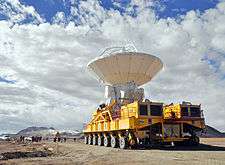
The Llano de Chajnantor is a 5,100-metre-high (16,700 ft) plateau in the Atacama Desert, about 50 kilometres (31 mi) east of San Pedro de Atacama. The site is 750 metres (2,460 ft) higher than the Mauna Kea Observatory and 2,400 metres (7,900 ft) higher than the VLT in Cerro Paranal. It is dry and inhospitable to humans, but a good site for submillimetre astronomy; because water vapor molecules in Earth's atmosphere absorb and attenuate submillimetre radiation, a dry site is required for this type of radio astronomy.[73] The telescopes are:
- Atacama Cosmology Telescope (ACT; not operated by ESO)
- Atacama Pathfinder Experiment
- Atacama Large Millimeter Array
- Q/U Imaging Experiment (QUIET; not operated by ESO)
- POLARBEAR (on the Huan Tran Telescope; not operated by ESO)
APEX and ALMA are telescopes designed for millimetre and submillimetre astronomy. This type of astronomy is a relatively unexplored frontier, revealing a universe which cannot be seen in more-familiar visible or infrared light and ideal for studying the "cold universe"; light at these wavelengths shines from vast cold clouds in interstellar space at temperatures only a few tens of degrees above absolute zero. Astronomers use this light to study the chemical and physical conditions in these molecular clouds, the dense regions of gas and cosmic dust where new stars are being born. Seen in visible light, these regions of the universe are often dark and obscure due to dust; however, they shine brightly in the millimetre and submillimetre portions of the electromagnetic spectrum. This wavelength range is also ideal for studying some of the earliest (and most distant) galaxies in the universe, whose light has been redshifted into longer wavelengths from the expansion of the universe.[74][75]
Atacama Pathfinder Experiment
The Atacama Pathfinder Experiment telescope is operated by ESO in collaboration with the Max Planck Institute for Radio Astronomy in Bonn, Germany and the Onsala Space Observatory in Onsala, Sweden. It is a 12-metre (39 ft)-diameter telescope operating at millimetre and submillimetre wavelengths, the largest of its kind in the southern hemisphere.[76][77] APEX is a precursor of ALMA (the Atacama Large Millimeter Array), an astronomical interferometer which ESO and its international partners is building on the Chajnantor plateau. APEX is based on a prototype ALMA antenna that is modified to be operated as single dish radio telescope.
Atacama Large Millimeter/submillimeter Array
ALMA is an astronomical interferometer of innovative design, initially composed of 66 high-precision antennas and operating at wavelengths of 0.3 to 3.6 mm. Its main array will have 50 12-metre (39 ft) antennas acting as a single interferometer. An additional compact array of four 12-metre and twelve 7-metre (23 ft) antennas is also planned. The antennas can be arranged across the desert plateau over distances from 150 metres to 16 kilometres (9.9 mi), which will give ALMA a variable "zoom". The array will be able to probe the universe at millimeter and submillimeter wavelengths with unprecedented sensitivity and resolution, with vision up to ten times sharper than the Hubble Space Telescope. These images will complement those made with the VLT Interferometer.[78] ALMA is a collaboration between East Asia (Japan and Taiwan), Europe (ESO), North America (USA and Canada) and Chile.
The scientific goals of ALMA include studying the origin and formation of stars, galaxies, and planets with observations of molecular gas and dust, studying distant galaxies towards the edge of the observable universe and studying relic radiation from the Big Bang.[79] A call for ALMA science proposals was issued on 31 March 2011,[80] and early observations began on 3 October.[81][82]
ESO telescopes: research and discoveries
Search for extrasolar planets

"Is there life elsewhere in the universe?" is one of humankind's most profound unanswered questions. A step in the attempt to answer this question is the search for planets outside the Solar System. ESO's observatories are equipped with an arsenal of instruments for finding, studying, and monitoring extrasolar planets. In 2004, the Very Large Telescope detected a faint glow from an apparent planet orbiting a star about 200 light-years from earth. A year later, this detection was confirmed as the first picture of an exoplanet ever recorded. Although the planet is large (five times more massive than Jupiter), this observation is a first step toward identifying the physical structure and chemical composition of exoplanets.[83][84]
Despite the fact that planets seem very common in the universe they are tiny, faint objects at cosmic scales; this makes their detection difficult with current technology. For this reason, most exoplanets have been detected with indirect methods. Of these, the most successful has been the radial velocity method. HARPS (the High Accuracy Radial-velocity Planet Searcher) has allowed the discovery of a number of planets with masses below that of Neptune orbiting nearby stars.[85] However, few of these planets are among the smallest ever discovered, or reside in its star's habitable zone. The possibility exists that one of these planets is covered by oceans; this discovery is an encouraging result in the search for planets which could support life.[86]
The Danish 1.54-metre telescope at La Silla participated in the discovery of one of the most Earth-like planets found to date. The planet, detected using the microlensing technique and about five times as massive as Earth, circles its parent star in about 10 years and most certainly has a rocky and icy surface.[87][88]
Age of the universe

With the Very Large Telescope, astronomers have made an independent determination of the age of the universe and shed new light on the earliest stages of the Milky Way. For the first time, they measured the amount of the radioactive isotope uranium-238 in a star born when the Milky Way was still forming.[89]
Like carbon dating over longer timescales, the uranium clock measures the age of a star. It shows that this star is 12.5 billion years old. Because the star cannot be older than the universe itself, the universe must be older than this. This agrees with known cosmology, which gives an age of the universe of 13.8 billion years. The star (and the Milky Way) must have formed soon after the Big Bang.[90]
Another result is the first measurement of the beryllium content of two stars in a Milky Way globular cluster. With this measurement, astronomers found that the first generation of stars in our galaxy must have formed soon after the end of the 200-million-year "Dark Age" following the Big Bang.[91]
Milky Way black hole
Astronomers long suspected that a black hole exists at the center of the Milky Way, but their theory was unproven. Conclusive evidence was obtained after 16 years of monitoring the Galactic Center with ESO telescopes at the La Silla and Paranal observatories.
Stars at the centre of the Milky Way are so densely packed that special imaging techniques (such as adaptive optics) were needed to boost the resolution of the VLT. Thanks to these techniques, astronomers were able to watch individual stars with unprecedented accuracy as they circled the Galactic Center.[92] Their paths conclusively demonstrated that they were orbiting in the immense gravitational grip of a supermassive black hole nearly three million times more massive than the sun.[93] The VLT observations also revealed flashes of infrared light emerging from the region at regular intervals. While the cause of this phenomenon is unknown, observers have suggested that the black hole may be spinning rapidly.[94]
The VLT has also peered into the centre of galaxies beyond our own, where clear signs of activity produced by supermassive black holes are found.[95] In the active galaxy NGC 1097, a complex network of filaments spiraling from the main part of the galaxy to its centre was seen in great detail.[96]
Gamma-ray bursts
Gamma-ray bursts (GRBs) are bursts of highly energetic gamma rays lasting from less than one second to several minutes. They are known to occur at great distances from earth, near the limits of the observable universe.
The VLT has observed the afterglow of the farthest known gamma-ray burst. With a measured redshift of 8.2, the light from this very remote astronomical source has taken more than 13 billion years to reach the earth. It occurred when the universe was less than 600 million years old (less than five percent of its present age), and released 300 times as much energy in a few seconds as the sun will in its entire lifetime (more than 10 billion years).[97]
The nature of these explosions has long been a mystery. Observations show that GRBs are one of two types: short- (less than a few seconds) and long-duration. Until 2003, it was suspected that two different types of cosmic event caused them. In 2003, ESO telescopes followed the aftermath of an explosion for one month. Their data showed that the light had similar properties to that of a supernova, and allowed astronomers to link long-duration GRBs with the ultimate explosions of massive stars (hypernovae).[98] In 2005, ESO telescopes detected visible light after a short-duration burst and tracked this light for three weeks. The conclusion was that short-duration bursts could not be caused by a hypernova; instead, it is thought that they originate in the violent merges of neutron stars or black holes.[99] Observations of gamma-ray-burst afterglows were coordinated between the VLT and the Atacama Pathfinder Experiment (APEX) to identify the possible counterpart (and its decay) at submillimeter wavelengths.[100]
Digital archives

The Science Archive Operation Group receives and redistributes ESO and Hubble Space Telescope data and provides archival support. About 12 terabytes of public data are distributed per year through the ESO archive in response to about 10,000 web requests. Additionally, more than 2,000 CDs and DVDs of proprietary data are sent out annually to principal investigators for service-mode observations. The archive is about 65 TB, with an input rate of about 15 TB per year; this is being increased by a factor of 10 or so due to the survey telescopes' data-production rate.
Breakthroughs in telescope, detector and computer technology now allow astronomical surveys to produce large numbers of images, spectra and catalogues. These data sets cover the sky at all wavelengths, from gamma- and X-rays through optical, infrared and radio waves. Astronomers are developing ways to make the large amount of data easily accessible. These techniques use the grid paradigm of distributed computing with seamless, transparent access to data through virtual observatories (VOs). As a physical observatory has telescopes with unique astronomical instruments, a VO consists of data centres with unique collections of astronomical data, software systems and processing capabilities. This global, community-based initiative is being developed under the International Virtual Observatory Alliance[101] and in Europe as part of the EURO-VO project.[102]
VOs have proven their effectiveness in a number of ways, including discovering 31 optically faint, obscured quasar candidates in existing Great Observatories Origins Deep Survey(GOODS) fields (quadrupling the number previously found). The discovery means that surveys of supermassive black holes have underestimated their numbers by a factor of two to five.[103]
Major discoveries



- Proxima Centauri b, the closest potentially habitable exoplanet
- An ESO team led by Guillem Anglada-Escudé found Proxima Centauri b. The discovery was reported in Nature on 24 August 2016.
- Stars orbiting Milky Way black hole
- Several of ESO telescopes were used in a 16-year study to obtain the most detailed view to date of the surroundings of the supermassive black hole at the centre of the galaxy.[61][92]
- Accelerating universe
- Two independent research teams have shown that the universe's expansion is accelerating, based on exploding-star observations with astronomical telescopes at La Silla.[104] The research teams were awarded the 2011 Nobel Prize in Physics for their discovery.[105]
- Oldest known Milky Way star
- Using ESO's VLT, astronomers have measured the age of the oldest known star in the Milky Way. At 13.2 billion years, the star was born in the universe's earliest era of star formation.[91] However, the oldest star seems to be 13.6 billion years old, and the Methuselah star might be even older.
- Measuring exoplanet spectra and atmosphere
- The atmosphere around an exoplanet has been analysed for the first time with the VLT. The planet, GJ 1214b, was studied as it passed in front of its parent star and starlight passed through the planet’s atmosphere.[106]
- First image of exoplanet
- The VLT has obtained the first image of a planet outside the Solar System. The 5-Jupiter-mass planet orbits a failed star—a brown dwarf—at a distance of 55 times the mean Earth-Sun distance.[107]
- Rich planetary system
- Astronomers using HARPS have discovered a planetary system (with at least five planets) orbiting a sunlike star, HD 10180. Two other planets may be present, one of which would have the lowest mass ever found.[108]
- Supermassive black hole flares at Milky Way centre
- The VLT and APEX collaborated to study violent flares from the supermassive black hole at the centre of the Milky Way, revealing material stretched as it orbits in the intense gravitational field near the central black hole.[109]
- Gamma-ray bursts
- ESO telescopes have provided proof that long gamma-ray bursts are linked with the explosion of massive stars; short gamma-ray bursts seem to be produced by merging neutron stars.[98]
- Milky Way stellar motion
- After more than 1,000 nights of observation at La Silla over a 15-year period, astronomers have determined the motion of more than 14,000 sunlike stars in the vicinity of the sun (demonstrating that the Milky Way is more turbulent and chaotic than previously thought).[110]
- Cosmic-temperature measurements
- The VLT has detected, for the first time, carbon-monoxide molecules in a galaxy located almost 11 billion light-years away. This has allowed astronomers to obtain a precise measurement of cosmic temperature at such a remote location.[111]
Outreach

Outreach activities are carried out by the ESO education and Public Outreach Department (ePOD).[113] These include a range of programs and products that aim to meet the requirements of media, science communicators and the public, such as press releases, images, videos and printed material.[114][115][116] Events such as the 2009 International Year of Astronomy (IYA2009) (with IAU and UNESCO), VLT First Light, Astronomy Online and the Comet Shoemaker–Levy 9 impact, have been reported by the Department.[57][117][118] ePOD organises exhibitions and educational campaigns, such as Venus Transit, Science on Stage and Science in School.[119][120][121][122][123]
ePOD also manages the ESO Supernova Planetarium & Visitor Centre, an astronomy centre located at the site of the ESO Headquarters in Garching bei München, currently under construction and scheduled to open in late 2017.[124]
A collection of photos and videos can be found in the ESO Public Image Gallery and Video Library.[125][126] Products from educational material to press kits may be downloaded from the ePOD website or ordered in physical form.[127][128]
As part of the Department, European outreach for the NASA/ESA Hubble Space Telescope provides comprehensive information about the telescope and its scientific discoveries. The International Astronomical Union (IAU) Press Office is also hosted by ePOD.[129]
Publications
ESO press releases describe scientific, technical and organisational developments and achievements and results obtained by scientists with ESO facilities. The organisation publishes three types of press releases.[131] Science releases describe results (usually appearing in a peer-reviewed journal) involving data from ESO observatories or staff. Organisational releases cover a range of themes related to ESO operations, including news on current and future observatories, new astronomical instruments and announcements of exhibitions worldwide. ESO also selects its best astronomical images, and presents them publicly in periodic photo releases. All press releases (dating back to 1985) are available online. There are child-friendly versions[132] and press releases translated into the languages of ESO's member countries.
The Messenger is a quarterly journal which has presented ESO's activities to the public since May 1974. All back copies are available for download.[133] ESO also publishes announcements[134] and Pictures of the Week[135] on its website. Announcements are shorter than press releases (typically less than 200 words) highlighting stories and events of interest to the community. Pictures of the Week show beautiful (or interesting) photos from ESO telescopes, and may highlight recent events or archival photos. All former entries are available on the website.
ESOcast[136] is a video-podcast series dedicated to reporting news and research from ESO. The universe's frontier is explored with "Doctor J" (Dr. Joe Liske, a German astronomer at ESO). Liske's scientific interests are in cosmology, particularly galaxy evolution and quasars.[137]
In 2013, the IMAX documentary Hidden Universe 3D was produced in cooperation of Cinema Productions, Film Victoria, Swinburne University of Technology, and the European Southern Observatory.
Video gallery
-
ESO's 50th-anniversary event (Munich Residenz in Germany, 11 October 2012)
-
ESO's first 50 years of exploring the southern sky
-
José Manuel Barroso visits the ESO in January 2013.
-
Tim de Zeeuw talks on ESO and its 50th Anniversary.
-
The temporary office buildings at the ESO Headquarters in Garching being dismantled.
-
Timelapses of ESO's VLT, ALMA and La Silla site
Image gallery
These images are from ESO's top-100 list.
-
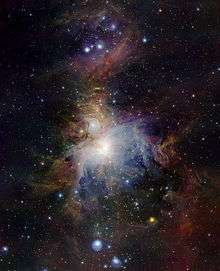
VISTA's infrared view of the Orion Nebula
-
.jpg)
The Helix Nebula
-

The Globular Cluster Omega Centauri
-

A 340-million pixel starscape from Paranal
-

NGC 2264 and the Christmas Tree cluster
-

The Centre of the Milky Way
-

NGC 2467 and Surroundings
-

The Horsehead Nebula
-

Messier 78: a reflection nebula in Orion
-

The WR 22 and Eta Carinae regions of the Carina Nebula
-

The hidden fires of the Flame Nebula
-

Early morning on Paranal
-
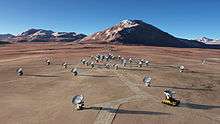
The future ALMA array on Chajnantor (artist's rendering)
-

Rare 360-degree Panorama of the Southern Sky
-
.jpg)
370-million-pixel starscape of the Lagoon Nebula
-
.jpg)
The Milky Way panorama
-

The Omega Nebula
-
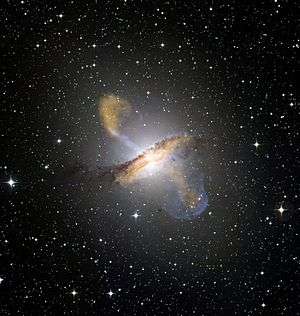
Centaurus A
-

Glowing Stellar Nurseries
-

The R Coronae Australis region imaged with the Wide Field Imager at La Silla
See also
- Cerro Tololo Inter-American Observatory, U.S. main site in Chile
- European Extremely Large Telescope, ESO's largest telescope under construction
- European Northern Observatory
- Roque de los Muchachos Observatory, telescopes on the Canary Islands, Spain
- Teide Observatory, telescopes on the Canary Islands, Spain
References
- ↑ "About ESO". 2012-04-02. Retrieved 2015-01-02.
- ↑ "ALMA website". Retrieved 2011-09-21.
- ↑ "Welcome to ALMA!". Retrieved 2011-05-25.
- ↑ "ESO Archive". Retrieved 2011-04-28.
- ↑ "A gamma-ray burst at a redshift of 8.2". Retrieved 2011-09-21.
- ↑ Gillessen, S.; Eisenhauer, F.; Trippe, S.; Alexander, T.; et al. (1970). "Monitoring stellar orbits around the Massive Black Hole in the Galactic Center". The Astrophysical Journal. 692 (2): 1075. arXiv:0810.4674
 . Bibcode:2009ApJ...692.1075G. doi:10.1088/0004-637X/692/2/1075.
. Bibcode:2009ApJ...692.1075G. doi:10.1088/0004-637X/692/2/1075. - ↑ Chauvin, G.; Lagrange, A.-M.; Dumas, C.; Zuckerman, B.; et al. (2004). "A giant planet candidate near a young brown dwarf. Direct VLT/NACO observations using IR wavefront sensing". Astronomy and Astrophysics. 425 (2): L29. arXiv:astro-ph/0409323
 . Bibcode:2004A&A...425L..29C. doi:10.1051/0004-6361:200400056.
. Bibcode:2004A&A...425L..29C. doi:10.1051/0004-6361:200400056. - ↑ "The HARPS Home page". Retrieved 2011-09-21.
- ↑ "Gala Event Celebrates 50 Years of the European Southern Observatory". ESO Press Release. Retrieved 14 October 2012.
- ↑ Adriaan Blaauw (1991). ESO's Early History. ESO. p. 4.
- 1 2 "ESO Timeline". Retrieved 2011-04-28.
- ↑ Lodewijk Woltjer (2006). Europe's Quest for the Universe. EDP Sciences.
- ↑ "Past ESO Directors General". Retrieved 2011-04-29.
- ↑ Adriaan Blaauw (1991). ESO's Early History. ESO.
- ↑ Adriaan Blaauw (1991). ESO's Early History. ESO. p. 7.
- ↑ Adriaan Blaauw (1991). ESO's Early History. ESO. p. 8.
- ↑ Adriaan Blaauw (1991). ESO's Early History. ESO. pp. 169, 179.
- ↑ "ESO Expands its Headquarters". ESO Press Release. Retrieved 13 April 2012.
- ↑ http://www.eso.org/public/about-eso/memberstates/
- ↑ "A Timeless Sanctuary in Santiago — The ESO Guesthouse, Then and Now". ESO Picture of the Week. Retrieved 13 February 2013.
- ↑ "Fernando Comerón becomes ESO Representative in Chile". ESO. Retrieved 4 April 2013.
- ↑ "The best observing sites on Earth". Retrieved 2011-05-13.
- 1 2 "The E-ELT project". Retrieved 2011-04-29.
- ↑ James Vincent (19 June 2014). "European Extremely Large Telescope to break ground (using dynamite) live later today". The Independent.
- ↑ "E-ELT Site Chosen". ESO. 26 April 2010. Retrieved 2011-04-29.
- ↑ "Comprehensive characterization of astronomical sites". Retrieved 2011-10-04.
- ↑ "Conference Astronomical Site Testing Data in Chile". Retrieved 2011-10-04.
- ↑ "ESO Publication Statistics" (PDF). Retrieved 2011-10-04.
- ↑ Satoru Iguchi; Morita, Koh-Ichiro; Sugimoto, Masahiro; Vila Vilaró, Baltasar; Saito, Masao; Hasegawa, Tetsuo; Kawabe, Ryohei; Tatematsu, Ken'Ichi; Seiichi, Seiichi; et al. (2009). "The Atacama Compact Array (ACA)". Publ. Astron. Soc. Japan. 61: 1–12. Bibcode:2009PASJ...61....1I. doi:10.1093/pasj/61.1.1. Retrieved 2011-04-29.
- ↑ "Science in Santiago". Retrieved 2011-10-04.
- ↑ "Minutes of the ESO Chile Joint Committee" (PDF). Retrieved 2011-10-05.
- ↑ "Cooperative Projects in Chile". Retrieved 2011-10-05.
- ↑ "Telescopes and Instrumentation". Retrieved 2011-04-29.
- ↑ "Observatories in Chile". Retrieved 2011-10-05.
- ↑ "Astronomers Find First Earth-like Planet in Habitable Zone". ESO. 25 April 2007. Retrieved 2011-04-28.
- ↑ "The HARPS search for southern extra-solar planets" (PDF). Retrieved 2011-10-04.
- ↑ "SN 1987A's Twentieth Anniversary". ESO. 24 February 2007. Retrieved 2011-05-04.
- ↑ "The ESO 3.6m Telescope". Retrieved 2011-05-05.
- ↑ "HARPS: The Planet Hunter". Retrieved 2011-05-05.
- ↑ "Raymond Wilson honoured with two prestigious prizes" (PDF). Retrieved 2011-10-05.
- ↑ "ESO NTT". Retrieved 2011-05-05.
- ↑ "WFI—Wide Field Imager". Retrieved 2011-04-29.
- ↑ "GROND Takes Off". ESO. 6 July 2007. Retrieved 2011-04-29.
- 1 2 "National and Project Telescopes". Retrieved 2011-04-29.
- ↑ "Extrasolar Planet in Double Star System Discovered from La Silla". ESO. 24 November 1998. Retrieved 2011-04-29.
- ↑ "Southern Sky extrasolar Planet search Programme". Retrieved 2011-10-05.
- ↑ "The Danish Telescope at La Silla". Retrieved 2011-04-29.
- ↑ "The Great Dane". Retrieved 18 June 2015.
- ↑ "Rapid Eye Mount". Retrieved 2011-04-29.
- ↑ Newscientist.com, Kelly Beatty - Former 'tenth planet' may be smaller than Pluto, November 2010
- ↑ "TAROT website". Retrieved 2011-05-04.
- ↑ "Paranal Site Details". Retrieved 2011-05-04.
- ↑ "Telescopes and Instrumentation". Retrieved 2011-05-04.
- ↑ "A Giant of Astronomy and a Quantum of Solace". ESO. 25 March 2008. Retrieved 2011-05-04.
- ↑ "IMDB—Quantum of Solace (2008)". Retrieved 2011-05-04.
- ↑ "The Very Large Telescope". Retrieved 2011-05-04.
- 1 2 "A Great Moment for Astronomy". ESO. 27 May 1998. Retrieved 2011-05-04.
- ↑ "Little Brother Joins the Large Family". ESO. 22 December 2006. Retrieved 2011-05-04.
- ↑ "ESO Science Library". Retrieved 2011-05-04.
- ↑ "Beta Pictoris planet finally imaged?". ESO. 21 November 2008. Retrieved 2011-05-04.
- 1 2 "Unprecedented 16-Year Long Study Tracks Stars Orbiting Milky Way Black Hole". ESO. 10 December 2008. Retrieved 2011-05-04.
- ↑ "NASA's Swift Catches Farthest Ever Gamma-Ray Burst". NASA. 19 September 2008. Retrieved 2011-05-04.
- ↑ "VLT Unit Telescopes Named at Paranal Inauguration". ESO. 6 March 1999. Retrieved 2011-05-04.
- ↑ "Names of VLT Unit Telescopes". Retrieved 2011-05-04.
- ↑ "On the Meaning of "YEPUN"". Retrieved 2011-05-04.
- ↑ "VISTA: Pioneering New Survey Telescope Starts Work". ESO. 11 December 2009. Retrieved 2011-05-04.
- ↑ "First stunning images captured by VISTA Telescope". STFC. 11 December 2009. Retrieved 2011-05-04.
- ↑ "Orion in a New Light". ESO. 10 February 2010. Retrieved 2011-05-04.
- ↑ "VISTA Stares Deeply into the Blue Lagoon". ESO. 5 January 2011. Retrieved 2011-05-04.
- ↑ "First Images from the VLT Survey Telescope". Retrieved 2011-10-05.
- ↑ "VLT Survey Telescope Center at Naples Web Portal". Retrieved 2011-05-04.
- ↑ "The ESO Survey Telescopes". Retrieved 2011-05-04.
- ↑ "ALMA Site Characterization and Monitoring". Retrieved 2011-10-05.
- ↑ "ESO APEX". Retrieved 2011-05-03.
- ↑ "ALMA Site – ALMA Science Portal". Retrieved 2011-05-04.
- ↑ "Atacama Pathfinder EXperiment APEX". Retrieved 2011-10-05.
- ↑ "ESO APEX". Retrieved 2011-05-04.
- ↑ "ESO ALMA". Retrieved 2011-05-04.
- ↑ "ALMA Science—ALMA Science Portal". Retrieved 2011-05-04.
- ↑ "Call for Proposals—ALMA Science Portal". Retrieved 2011-05-04.
- ↑ "ALMA Early Science Cycle 0 Call for Proposals". NRAO. Retrieved 2011-05-04.
- ↑ "ALMA Opens its Eyes". Retrieved 2011-10-05.
- ↑ "Yes, it is the Image of an Exoplanet". ESO. 30 April 2005. Retrieved 2011-05-04.
- ↑ "Bad Astronomy, FIRST EXOPLANET IMAGE CONFIRMED!". Retrieved 2011-05-05.
- ↑ "Fifty New Exoplanets Discovered by HARPS". ESO. 12 September 2011. Retrieved 2011-05-04.
- ↑ "ESO Exoplanets". Retrieved 2011-05-05.
- ↑ "Discovery of a cool planet of 5.5 Earth masses through gravitational microlensing". Retrieved 2011-05-05.
- ↑ "It's Far, It's Small, It's Cool: It's an Icy Exoplanet!". ESO. 25 January 2006. Retrieved 2011-05-04.
- ↑ "How Old is the Universe?". ESO. 7 February 2001. Retrieved 2011-04-05.
- ↑ "ESO Very Old Stars". Retrieved 2011-05-05.
- 1 2 "How Old is the Milky Way?". ESO. 17 August 2004. Retrieved 2011-04-05.
- 1 2 "Surfing a Black Hole". ESO. 16 October 2002. Retrieved 2011-04-05.
- ↑ "Messages from the Abyss". ESO. 29 October 2003. Retrieved 2011-04-05.
- ↑ "Unprecedented 16-Year Long Study Tracks Stars Orbiting Milky Way Black Hole". ESO. 12 October 2008. Retrieved 2011-04-05.
- ↑ "A Supermassive Black Hole in a Nearby Galaxy". ESO. 8 March 2001. Retrieved 2011-04-05.
- ↑ "Feeding the Monster". ESO. 17 October 2005. Retrieved 2011-04-05.
- ↑ "The Most Distant Object Yet Discovered in the Universe". ESO. 28 April 2009. Retrieved 2011-04-05.
- 1 2 "Cosmological Gamma-Ray Bursts and Hypernovae Conclusively Linked". ESO. 18 June 2003. Retrieved 2011-04-05.
- ↑ "Witnessing the Flash from a Black Hole's Cannibal Act". ESO. 14 December 2005. Retrieved 2011-04-05.
- ↑ "GCN CIRCULAR, GRB 100814A: Submm observations from APEX, NASA email message".
- ↑ International Virtual Observatory Alliance. Ivoa.net. Retrieved on 2011-04-05.
- ↑ European Virtual Observatory. Euro-vo.org. Retrieved on 2011-04-05.
- ↑ "Missing Black Holes Driven Out". ESO. 28 May 2004. Retrieved 2011-04-05.
- ↑ "Distant Supernovae Indicate Ever-Expanding Universe". ESO. 15 December 1998. Retrieved 2011-04-05.
- ↑ "Scientists studying universe's expansion win Nobel Prize in Physics". CNN. 4 October 2011. Retrieved 2011-10-04.
- ↑ "VLT Captures First Direct Spectrum of an Exoplanet". ESO. 13 January 2010. Retrieved 2011-04-05.
- ↑ "Is This Speck of Light an Exoplanet?". ESO. 10 September 2004. Retrieved 2011-04-05.
- ↑ "Richest Planetary System Discovered". ESO. 24 August 2010. Retrieved 2011-04-05.
- ↑ "Astronomers detect matter torn apart by black hole". ESO. 18 October 2008. Retrieved 2011-04-05.
- ↑ "Milky Way Past Was More Turbulent Than Previously Known". ESO. 6 April 2004. Retrieved 2011-04-05.
- ↑ "A Molecular Thermometer for the Distant Universe". ESO. 13 May 2008. Retrieved 2011-04-05.
- ↑ "Groundbreaking Ceremony for ESO Supernova Planetarium & Visitor Centre". ESO Announcement. European Southern Observatory. Retrieved 27 February 2015.
- ↑ "ESO ePOD". Retrieved 2011-10-06.
- ↑ "ESO Outreach". Retrieved 2011-05-05.
- ↑ "Press Releases". Retrieved 2011-10-06.
- ↑ "Products from the education and Public Outreach Department". Retrieved 2011-10-05.
- ↑ "Beyond International Year of Astronomy". Retrieved 2011-10-06.
- ↑ "The Big Comet Crash of 1994". ESO. 27 January 1994. Retrieved 2011-10-06.
- ↑ "ePOD exhibitions". Retrieved 2011-05-05.
- ↑ "Astronomical Events". Retrieved 2011-10-06.
- ↑ "The Venus Transit 2004". Retrieved 2011-10-06.
- ↑ "Science on Stage Europe". Retrieved 2011-10-06.
- ↑ "Science in School". Retrieved 2011-10-06.
- ↑ "ESO Supernova website".
- ↑ "Images". Retrieved 2011-10-06.
- ↑ "Videos". Retrieved 2011-10-05.
- ↑ "Educational Material". Retrieved 2011-10-06.
- ↑ "ESOshop". Retrieved 2011-10-06.
- ↑ "IAU Press Office". Retrieved 2011-05-05.
- ↑ "ESOcast". ESO Videos. ESO. Retrieved 18 June 2012.
- ↑ "ESO Press Room". Retrieved 2011-05-05.
- ↑ "Space Scoop: Astronomy News for Children". ESO. 13 April 2011. Retrieved 2011-05-06.
- ↑ "The Messenger". ESO. Retrieved December 22, 2012.
- ↑ "ESO Announcements". Retrieved 2011-05-05.
- ↑ "ESO Picture of the Week". Retrieved 2011-05-05.
- ↑ "ESOcast". Retrieved 2011-10-06.
- ↑ "Joe Liske's home". Retrieved 2011-05-05.
Bibliography
- Shaw, E. N. (1976). "The European Southern Observatory". The Observatory. London: Royal Astronomical Society.
- Council of Europe (2010). European Yearbook / Annuaire Européen. 58. Martinus Nijhoff Publishers. p. cdxliii. ISBN 9004206795.
- Lodewijk, Woltjer (2012). Europe's Quest for The Universe. EDP Sciences. ISBN 9782759801671.
- Schilling, Govert; Christensen, Lars Lindberg (2013). Europe to the Stars: ESO's first 50 years of exploring the southern sky. John Wiley & Sons. ISBN 9783527671670.
External links
| Wikimedia Commons has media related to European Southern Observatory. |
- Atacama Large Millimeter Array
- APEX telescope
- ESO
- ESO Top 100 Images
- Webpage for the ESO telescopes at La Silla Observatory
- Paranal Observatory
- James Bond at Paranal
- ESOcast
- ESO Vimeo channel
- 2011 video explaining the current and planned work of ESO
Coordinates: 48°15′36″N 11°40′16″E / 48.26000°N 11.67111°E
_logo.svg.png)
.jpg)

